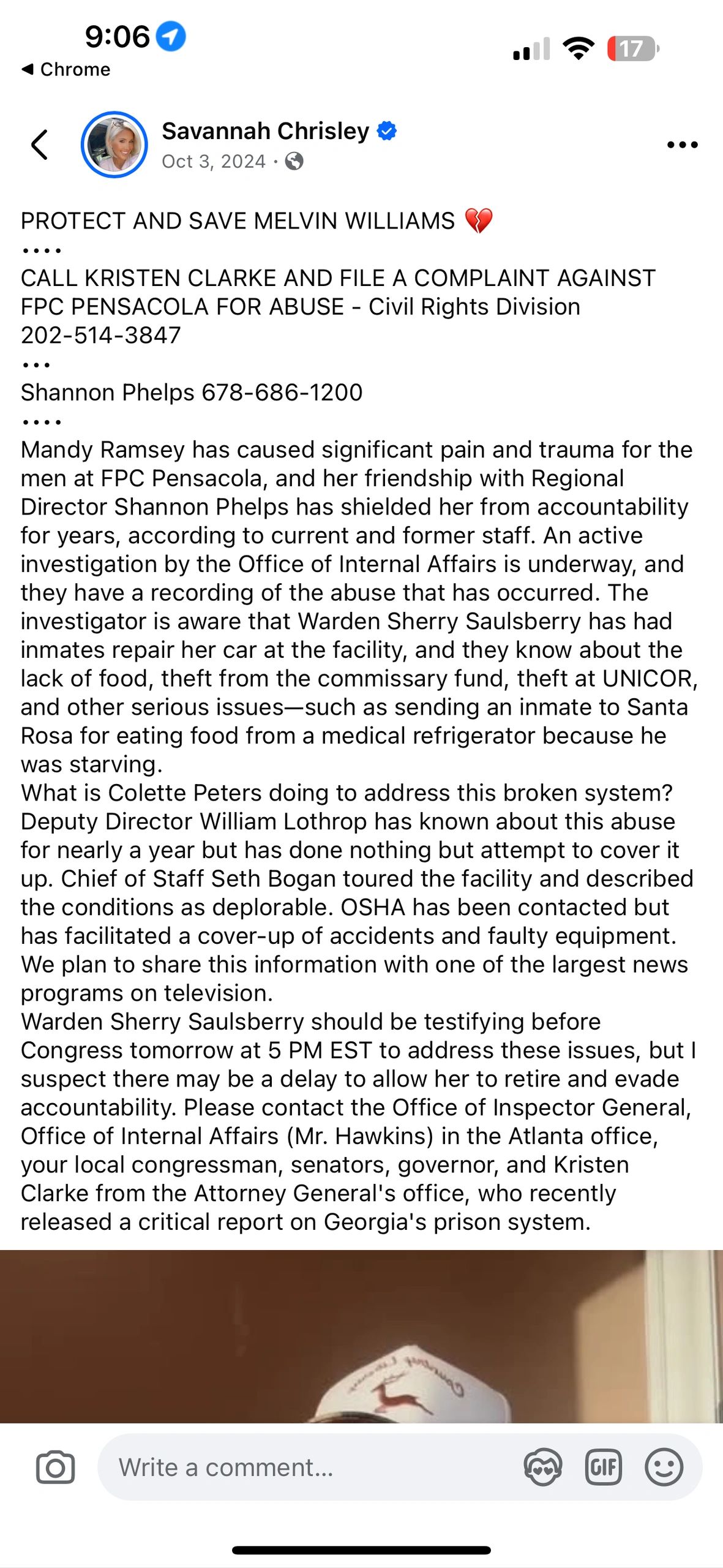This is yet another dirty cop that Savannah threw her support behind. Even after overwhelming evidence that he beat and murdered a suspect, Savannah feels the need to have him released. Why does she continue to support obviously guilty people, especially ones that abuse power that she complains about in Todd’s prison.. Pick a side…


The case of Melvin Williams, a former New Orleans police officer convicted for civil rights violations, represents a significant chapter in the ongoing struggle for police accountability and civil rights protection. This detailed examination covers the incident, legal proceedings, evidence, and current status, providing a comprehensive overview for readers interested in true crime and systemic issues within law enforcement.
Incident and Background
On July 30, 2005, Melvin Williams, a 16-year veteran of the NOPD, and his partner Matthew Dean Moore, a recent academy graduate, encountered Raymond Robair, a 48-year-old handyman, in the Treme neighborhood of New Orleans. According to witness testimonies, Williams initiated a violent assault, kicking Robair and beating him repeatedly with a baton. The officers then transported Robair to Charity Hospital, where they falsely claimed he was found under a bridge and was a drug user, leading to a misdiagnosis of drug overdose rather than treatment for blunt force trauma. Robair died within hours, with medical examinations later revealing fractured ribs and a ruptured spleen.
This incident occurred against a backdrop of reported systemic issues within the NOPD, particularly highlighted by post-Hurricane Katrina investigations into police misconduct. The case of Williams and Moore is one of several Justice Department probes into alleged abuses by New Orleans officers, underscoring a pattern of brutality and cover-ups.

Investigation and Legal Proceedings
Initially, the investigation into Robair’s death was inadequate, with the New Orleans coroner’s office declaring it accidental. However, in 2008, the FBI reopened the case, obtaining new witness statements and evidence. This led to indictments in 2010, charging Williams with violating Robair’s constitutional rights under color of law and both officers with obstruction of justice for submitting false reports.
The trial commenced in April 2011, and a federal jury convicted Williams of civil rights violations and obstruction of justice, and Moore of obstruction of justice and lying to the FBI. Sentencing followed in September 2011, with Williams receiving 262 months (over 21 years) in prison and Moore 70 months (over 5 years). U.S. District Judge Eldon Fallon presided, noting during sentencing the severity of the abuse and the need for accountability.
Legal opinions from the case emphasized the gravity of police misconduct. U.S. Attorney Jim Letten stated, “We will not tolerate any abuse of our citizens by those who wear the badge,” highlighting the betrayal of public trust. Judge Fallon remarked on Moore’s inaction, saying, “He did nothing” during the beating and cover-up. FBI Special Agent David Welker added, “Officers screw up, cover up, and hope no one finds out,” calling for reforms to ensure the NOPD “does right when no one is looking.”
Evidence and Legal Analysis
The prosecution’s case was built on robust evidence, including:
Details
Witness Testimonies
Neighbors saw Williams kick Robair and beat him with a baton, contradicting officers’ claims.
Medical Evidence
Autopsies showed fractured ribs and a ruptured spleen, inconsistent with a fall, as claimed.
False Reports
Officers lied to hospital staff and federal agents, submitting inaccurate incident reports.
A second autopsy, commissioned by Robair’s family, documented 23 separate bruises, including a thigh contusion over a foot long, further contradicting initial findings. Legal analyses, such as those from the 5th Circuit Court of Appeals in 2013, upheld the convictions, finding sufficient evidence to support the jury’s verdict, particularly noting the officers’ cover-up efforts.

Appeals and Post-Conviction Developments
Following their convictions, Williams and Moore’s attorneys vowed to appeal, arguing various legal points. However, in 2013, the 5th U.S. Circuit Court of Appeals upheld the convictions and sentences, ruling there was ample evidence for the jury’s decision (Federal appeals court upholds guilty verdicts, sentences for 2 NOPD officers in Robair beating death | NOLA.com). This decision closed the door on further direct appeals, solidifying the legal outcome.
Current Status and Ongoing Implications
As of March 22, 2025, there are no public records indicating Melvin Williams’ release from prison. Given his sentence of over 21 years, starting in 2011, it is likely he remains incarcerated, though exact details are not publicly available. This lack of information is not uncommon for federal inmates, and without specific updates, we can infer he is still serving his term.
The case has had broader implications, including civil lawsuits by Robair’s family. In 2016, the city of New Orleans settled for $13.3 million with relatives of victims, including Robair’s family, acknowledging past misconduct (Mayor: $13.3M settlements end hard part of New Orleans’ past – NBC News). This settlement reflects ongoing efforts to address historical injustices within the NOPD, with current District Attorney Jason Williams focusing on post-conviction relief and civil rights protections.
Conclusion
The conviction of Melvin Williams for civil rights violations in the beating death of Raymond Robair remains a pivotal moment in New Orleans’ history of police misconduct. It underscores the importance of thorough investigations, witness testimony, and medical evidence in securing justice. While Williams’ current status suggests he is still serving his sentence, the case continues to serve as a reminder of the need for ongoing reform and accountability within law enforcement, particularly in addressing systemic issues of brutality and cover-ups.
Key Citations
- Two former New Orleans police officers sentenced for role in 2005 fatal beating and police cover-up | Crime/Police | nola.com
- Office of Public Affairs | Two New Orleans Police Officers Convicted on Civil Rights and Obstruction of Justice Charges in Connection with the … | Department of Justice
- Two NOPD Officers Convicted in Beating Death | FRONTLINE
- Judge refuses to toss lawsuit over fatal police beating of Raymond Robair – nola.com
- Federal appeals court upholds guilty verdicts, sentences for 2 NOPD officers in Robair beating death | NOLA.com
- Mayor: $13.3M settlements end hard part of New Orleans’ past – NBC News

